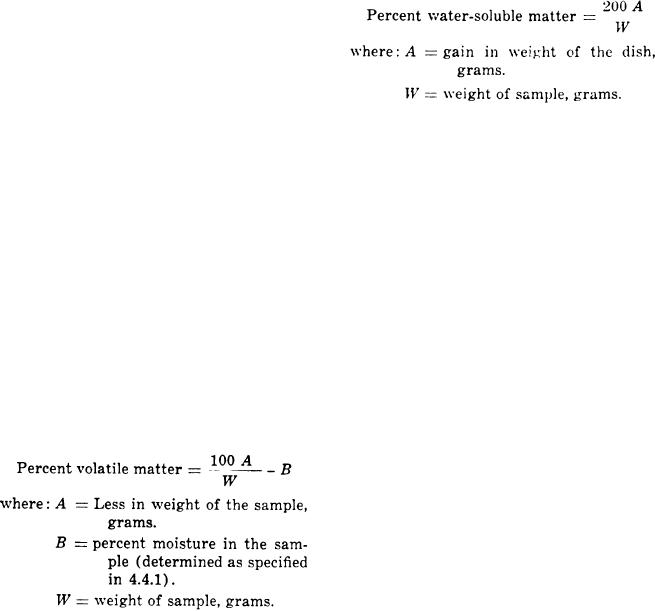 |
|||
|
|
|||
| ||||||||||
|
|  MIL-A-3850
shall be such that when the crucible is placed
centage of water-soluble matter in the sample,
1 inch above the burner, a temperature of
as follows:
950 20C. shall be maintained inside the
crucible. Check the temperature inside the
crucible with a pyrometer before starting the
determination, by inserting the thermocouple
through a hole in an asbestos lid fitted to the
platinum crucible and placing the junction of
the thermocouple in contact with the bottom
4.4.6 Ash. --Transfer an accurately weighed
of the crucible (see 6.5).
portion of 1 to 2 grams of the sample to a
tared platinum or porcelain crucible, and ig-
4.4.4.2 Procedure. --Transfer an accurate-
nite with a gas flame, or a muffle furnace.
ly weighed portion of approximately 1.00
Continue heating until all combustible matter
gram of the sample to the tared platinum cru-
is consumed, cool in a desiccator, and weigh.
cible. Cover the crucible, making certain that
Calculate the weight of the residue in the
the lid fits tightly all around the edge, and
crucible to percent ash in the material.
place the crucible upright in a nichrome or
vitreosil triangle adjusted so that the bottom
4.4.7 pH value of water extract. --Transfer
of the crucible is approximately 1 inch above
an accurately weighed portion of 2.0 grams
the top of the burner. Light the burner, and
of the sample to a flask fitted with a ground-
using the full flame allow the crucible to heat
glass stopper. Add 100 ml. of hot freshly
for 7 minutes. Extinguish the flame at
boiled distilled water having a pH of 6.0
the end of this period, and when the crucible
0.5, and stopper the flask. Shake the flask to
and contents have cooled to below a red heat
obtain complete dispersion of the sample,
place them in a desiccator, and weigh when
and then allow it to stand for 2 hours with
cooled. Calculate the percent volatile matter
occasional shaking. Cool the mixture if neces-
as follows:
sary and determine the pH of the solution at
25 2 C. by means of a pH meter which
reads directly in pH units and is capable of
measuring accurately to within 0.1 pH unit.
The pH meter shall be equipped with a glass
electrode and a saturated calomel electrode
(see 6.6) and shall be calibrated with stand-
ard buffer solutions (see 6.7). In cases of
dispute the standard buffer solutions pre-
scribed by the U. S. Bureau of Standards shall
4.4.5 Water-soluble matter. --Transfer an
be used to calibrate the pH meter.
accurately weighed portion of approximately
4.4.8 Apparent density. --Assemble a Scott
5 gm. of the sample to a beaker, and add 150
ml. of distilled water. Boil for 15 minutes, cool,
Volumeter as shown in figure 1, placing a No.
and transfer to a 200-ml. volumetric flask.
40 U. S. Standard sieve, conforming to Speci-
fication RR-S-366, on the top hopper. The
Dilute to the mark with distilled water, and
mix. Allow the solution to settle, remove ap-
tared receiving cube, having a volume of 1
cubic inch, shall be placed directly under the
proximately two-thirds of the supermatant
liquid, and filter through a dry filter paper.
lower funnel, and resting on the base of the
Discard the first 10 ml. of the filtrate. Trans-
apparatus. Use a sufficient quantity of the
sample to fill the receiving cube to over-flow-
fer 100 ml. of the clear filtrate to a tared
ing. Pour the material slowly into the hopper,
evaporating dish. Evaporate to dryness, cool
brushing it through the sieve if necessary.
in a desiccator, and weigh. Calculate the per-
4
|
|
Privacy Statement - Press Release - Copyright Information. - Contact Us |